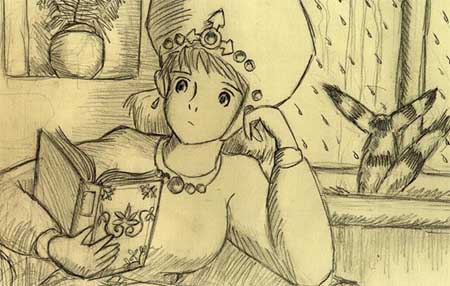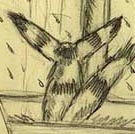|
This doesn't have much to do with Nausicaa, besides the fact that it tells the story of another person who is a strong advocate for cruelty-free teaching and has lived an extraordinary life. |
||||||||||||
 |
||||||||||||
|
She'd be interested in reading about him... so why not you too?? |
||||||||||||
|
~~ ~~ |
||||||||||||
|
"A good trainer can hear a horse speak to him. A great trainer can hear a horse whisper." Monty Roberts has been saying this phrase long before the book and movie The Horse Whisperer ever came out. The main character of this book is actually based on this man and his teachings. Monty Roberts is a celebrated horse trainer whose techniques are revolutionary to the horse industry. His autobiography The Man Who Listens to Horses was on the best sellers list for nearly two years. Because of his compassionate and highly effective techniques, the world is starting to realize that violence and intimidation is no longer the answer to not only training horses but for interacting with fellow human beings as well. |
||||||||||||
|
"Roberts has lived his whole life around horses. His father was a horse trainer and he wanted his son to follow in his footsteps. From the age of three and up, Monty was entered in numerous shows and excelled. He won his first championship at age four (Rist 3). His father used Monty as a showcase for attracting business to his ranch. |
||||||||||||
|
Monty's father. however, was harsh and short tempered and never hesitated to use violence. Both his family and his animal subjects would frequently feel his wrath. Monty remembers, even at a very young age, disliking his fathers training techniques and wondering if there was an alternative (Roberts 1) |
||||||||||||
|
When Monty was around thirteen, he became highly involved with the rodeo circuit. However he became disillusioned with the inhumane ways that horses and other animals were treated. Once again, as with his father, he began to break away from the tradition and search for better methods. |
||||||||||||
|
At this time, Monty was employed by the rodeo to search for and round up wild mustangs for one of their events (Roberts 1). He would spend weeks at a time on horseback, following a single herd of mustangs. It was during this time that Monty was able to make his first crucial observations on equine behavior. What Roberts learned from watching these horses would serve as a foundation for his philosophy in years to come. |
||||||||||||
|
Horses, either in the wild or tame, are very social creatures with extremely strong herd instincts. Their only means for survival is to stay close together so that every horse can be warned of the slightest impending danger. If they must fight back a predator, their strength is found in numbers. The horse's society is also built around a strict hierarchy. The leader of the herd, contrary to popular belief is not the stallion, but the eldest and strongest mare. This horse is called the head mare or "alpha mare" (Leatherman 2) The alpha mare is in charge of the herd will go to find food and water, and the discipline of the younger herd members. The worst form of punishment that the mare can use on an unruly horse, is to send it out away from the herd. All horses instinctively know that, if they are separated from the herd, their lives are in grave danger. This form of punishment is very effective and horses will quickly accept who the leader is. |
|
Roberts observed carefully how the mare would send the horse away. She would take on an aggressive stance with shoulders square and eyes in contact with the other horse. The mare would continuce this action, keeping the distressed horse at a distance that was desirable to her. In time the mare would take on a passive stance, where she would drop her head close to the ground. This is the signal that the horse has served it's sentence and can return to the herd (Roberts 2). |
||||
|
Roberts discovered that the human body, eventhough very different from that of the horse, can be used to generate the same signals of that of a dominant mare, or any other horse for that matter.He uses this to "train young unbroken horses to accept, saddle, bridle and rider without inflicting the slightest pain" (Marsh 1). Monty has named this silent language of signals and gestures "Equus". |
||||
|
The only tools Roberts needs to "start up" an untrained horse is a round pen, a long rope, and himself (Rist 3). Roberts will shake the rope and square his shoulders towards the horse to send it away repeatedly within the confines of the pen. After ample time of exhausting it's flight repsonse, the horse will become tired and confused and will want to turn to someone, anyone for help and guidance. At this point Monty will immediately emulate the passive stance of a forgiving mare, inviting the horse over to him. The herd instnct kicks in and the isolated horse needs a leader to feel secure and Monty has become that leader. Monty calls this moment of truth "join up" (Marsh 3). This method sounds very easy to use, but it takes an extremely well trained eye to look for the cues given by the horse. The process is also far from over. Once the horses trust is gained, it still must learn to accept equipment and rider. If it is done correctly not a bit of force or intimidation is used. |
||||
|
This method that Monty uses is a culmination of many years of experience, successes, and devistating failures. Throughout his life Monty's techniques have been looked with great apprehension from his fellow horse trainers. Roberts recalls the first time he demonstrated his findings to anyone. Monty was a young man at the time and never dreamed that anyone would find his discoveries less than fantastic. He privately showed his experiment to a family friend by taming a wild horse before his eyes. "Instead of the praise I expected, however, Ray stunned me by barking, 'That was a fluke! You could get hurt, I suggest you stop now" (Roberts 3). Even more drastic was what happened when he showed his father, who blurted out "What the hell am I raising?" and beat Monty with a stable chain until he was hospitalized. |
||||
|
For about forty years that followed, Monty worked underground, far away from the spotlight that he deserved. It was not until 1989 when his name was recommended to Queen Elizabeth. He was commissioned to come to the stables at Windsor Castle and train 16 cavalry horses (rist 3). After that monty won widespread fame and recognition. |
||||
|
Monty and his wife Pat, have taken in nearly fifty foster children at their ranch called "Flag Is Up". Caryn Coatney states that Monty "has tught the values of self respect, dignity, and meaningful work to children battlling drug addiction, kleptomania and eating disorders..."(1). They basically use the same techniques with the children as they do with the horses. They don't chase the kids around in a round pen, but besides that very little alterations to the methods are needed. Ann Marsh remarks on the way the Roberts' handle the children: "The Roberts' child-raising techniques are sheer simplicity. They neither coddle nor hector the kids. They are lavish with praise when the child does something right but don't criticize when the child stumbles (2). |
|
Large scale corporations are also using Monty and his philosophy for effective interpersonal relationship skills. Ann Marsh realizes that this has been used before: "(It's) the style of management that says you get more out of people by winning them over than by ordering them around. It's not a new message but it needs to be repackaged frequently and relearned by successive generations of bosses (1). |
|
Marsh also refers to a book written in 1960 by Dounglas McGregor entitled The Human Side of Enterprise. McGregor categorizes the two basic schools of thought of management into Theory X and Theory Y. Theory X states that workers need to watched over and forcefully directed, while Theory Y allows the workers to think for themselves and achieve a desire to do their very best (Marsh 2). Monty is, without a doubt, using the Theory Y philosophy with his horses and children with great results. Managers and corporate executives are starting to realize that a lot can be learned here, and Monty has been asked to speak for Ford, Disney, General Motors and Volkswagen to name only a few. |
|
Monty Roberts has rediscovered the alternative to abusing power to throw ones weight around. It is being proven that it works with people of all ages and backgrounds. It is such a drastic contrast to other methods that it makes some people voice their skepticism. I wholeheartedly agree when Roberts says, "The world is ready to say, 'No more violence'" (qtd. in Coatney 1). The horse has been a servant to humans for millennia. As time has moved forward, things have changed and we no longer need them as beasts of burden. I feel that way we introduce them to humans must change as well. Monty Roberts is showing the world how intelligent horses are and they can be reasoned with if one simply does it in a language that they can understand. Roberts says "I made a promise to myself that when I die, I will have made a better world for the horse, It's horses I owe everything to" (qtd. in Rist 4). |
|
22 November 1998 |
||||||||||
|
Works Cited: Coatney, Caryn. "One Man Wins Trust of Fellow Beings." |
||||||||||
|
The Christian Science Montor 9 July 1998: B6. |
||||||||||
|
Leatherman, Dale. "The Secret Lives of Horses." |
||||||||||
|
Equus April 1996: 32-41. |
||||||||||
|
Marsh, Ann. "The Man Who Listens to Horses." |
||||||||||
|
Forbes 4 May 1998: 122-127 |
||||||||||
|
Rist, Curtis. "Neigh Sayer." |
|
People Weekly 14 April 1997: 94-98. |
|
Roberts, Monty. "The Man Who Listens to Horses." |
|
Readers Digest Dec 1997: 148-153. |
|
|
|
The Man Who Listens to Horses |
|
by Monty Roberts |
|
copyright 1996,1997 by Monty Roberts |
|
published by Random House, Inc., New York |
|
Shy Boy |
|||||||
|
by Monty Roberts |
|||||||
|
photographs by Christopher Dydyk |
|||||||
|
copyright 1999 by Monty Roberts |
|||||||
|
published by HarperCollins publishing, New York |
|
Find out more about Monty Roberts' official website on the Teaching Resources page |
|
|
|
|
All text and artwork, unless otherwise specified, by Griffin Waldau. Updated December 20, 2000. |
|||||||||
|
|||||||||
|
-- |
||
